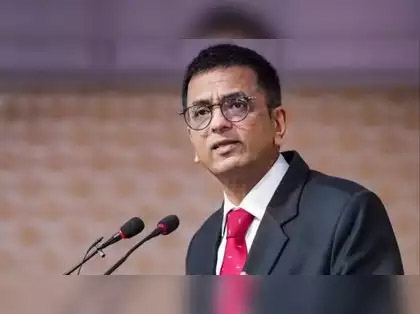By K Raveendran
It is as though the most controversial, at times even messy, part of Chief Justice D Y Chandrachud has been reserved for the last few days of his tenure. The revelation about his prayer to the deity to help the Supreme Court come up with a solution in the Ram Janmabhoomi dispute has had its political undertones as the deity was in a way a party to the dispute. But luckily, the claim did not lead to any clumsy results, although it may have created some distrust in the minds of the aggrieved parties. The invitation to prime minister Narendra Modi for the CJI’s private Ganesh puja also had its share of doubts.
Justice Chandrachud’s tenure has also been punctuated by tensions with legal practitioners over court protocols, particularly regarding case listings. As Chief Justice, he has been vocal about the need for procedural integrity, often expressing frustration over lawyers attempting to bypass standard case listing processes. His stance has highlighted a recurring issue within India’s judicial ecosystem, where the relationship between the bench and the bar has at times been strained by differing expectations on courtroom conduct and decorum.
But what stole the show really were his observations recorded in the majority verdict in the case relating to private property where Justice Chandrachud criticised former Justice V R Krishna Iyer, a judicial icon who is celebrated for his work in advancing social justice in India and has earned a permanent place in the heart and mind of every Indian, for his ‘rigid economic theory’. It can be safely assumed that these moments in his final days have overshadowed some of the broader judicial and institutional reforms that marked his tenure.
Krishna Iyer’s views have long been held in high esteem, particularly among progressive elements who view his economic philosophy as foundational to the judiciary’s pro-poor ethos. By calling attention to what he termed Iyer’s ‘rigid economic theory’, CJI Chandrachud has drawn the ire from some quarters, who view this critique as an affront to a cherished judicial legacy. Iyer’s legal philosophy, which emphasizes the judiciary’s role in championing the underprivileged, has inspired generations of Indian jurists and remains influential in contemporary judicial thought.
For some, this moment represents an overstep by Chandrachud. The criticism was so sharp that it seemed to risk tarnishing Iyer’s legacy, something which many legal minds found troubling. After all, judicial critiques of former judges are rare and can sometimes seem like a personal or political attack, especially when it comes to figures as revered as Justice Krishna Iyer. Was it really necessary for Chandrachud to go after Iyer’s economic views in a ruling that seemed to be focused more on property law than on a critique of ideological differences?
The criticism of Iyer may have been an attempt to push back against an outdated or overly idealistic notion of economics that doesn’t necessarily align with current societal realities. It probably stems from a realisation that Iyer’s ideas, though revolutionary in their time, may not be suited to a rapidly changing economic landscape. Chandrachud, from his own point of view, may have made this remark to assert that the court’s role as a dynamic institution that must evolve with the times. However, the manner in which the criticism was delivered—and the fact that it was directed at a figure as beloved and revered as Justice Krishna Iyer—has led to debates about the appropriateness of such a critique.
Some of his own colleagues have argued that by singling out Krishna Iyer’s stand, the CJI not only diminished the intellectual legacy of his predecessor but also presented a one-sided picture. They viewed this as an unnecessary rehashing of ideological differences, especially when Iyer’s approach was founded on the principle of social justice in an unequal society. They contended that the Supreme Court’s judgments should be above partisan or individual critiques of past legal luminaries, as it risks introducing divisiveness within the institution.
In their view, such remarks—especially from a sitting Chief Justice—could fuel unnecessary controversy and divert attention from the substantive issues at hand in the judgment itself. The judiciary is meant to be an impartial arbiter of legal disputes, not a forum for public ideological clashes. Justice Iyer’s economic theories may have been contested during his time, but his contributions to shaping India’s jurisprudence, especially in advancing rights for disadvantaged groups, should not have been subjected to a public disparagement by a fellow judge. These criticisms reflect broader concerns about maintaining judicial collegiality and respecting the diversity of thought within the highest judicial body in the land.
They earnestly believe that Justice Chandrachud’s remarks, while rooted in his interpretation of legal principles, may have crossed an unwritten line in judicial conduct. The need to uphold the dignity of the judiciary, they argue, must be balanced with the freedom to express legal opinions—especially when such expressions can inadvertently lead to the undermining of past judicial giants or sow seeds of discord within the institution itself. This internal critique has added another layer of complexity to the legacy of Chandrachud. (IPA Service)


